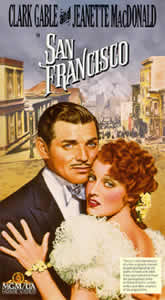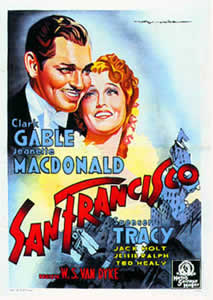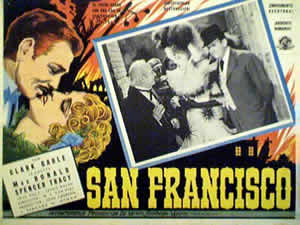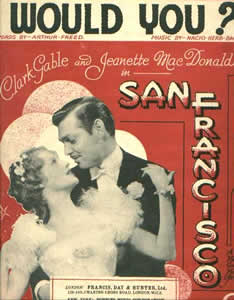|
SAN FRANCISCO
Abstract:
A spectacular re-creation of the great San Francisco earthquake highlights
this film about the romance between Barbary Coast nightclub owner Blackie
Norton (Clark Gable) and Mary Blake (Jeanette MacDonald), a singer. Mary loves
Blackie but fears that he will never reform. So, when she is offered a chance
to perform at the Tivoli Opera House, she accepts and leaves Blackie and his
club behind. Father Tim (Spencer Tracy), Blackie's boyhood friend, attempts
to persuade him to pursue her.
Summary:
 Clark Gable
was the leading star at M-G-M throughout the middle and late 1930's. His popularity
was the result of both his infectious screen presence and his portrayals of
virile, charismatic men; he was admired by women, who were mesmerized by his
good looks and charm, and liked by men as well. He won an Academy Award in
1934 for his performance opposite Claudette Colbert in IT HAPPENED ONE NIGHT,
and he was nominated again a year later for his work as Fletcher Christian
in MUTINY ON THE BOUNTY. His fame reached its height at the end of the decade
with the most representative of all Gable roles, that of Rhett Butler in GONE
WITH THE WIND (1939). Another role, however, which helped solidify his reputation
was that of Blackie Norton in SAN FRANCISCO. The character of Blackie, an
arrogant gambler with a tough veneer and a heart of gold, is tailor-made for
the star. The film is a lavish, entertaining product of Hollywood's golden
age and features some of the best special effects in the history of the cinema. Clark Gable
was the leading star at M-G-M throughout the middle and late 1930's. His popularity
was the result of both his infectious screen presence and his portrayals of
virile, charismatic men; he was admired by women, who were mesmerized by his
good looks and charm, and liked by men as well. He won an Academy Award in
1934 for his performance opposite Claudette Colbert in IT HAPPENED ONE NIGHT,
and he was nominated again a year later for his work as Fletcher Christian
in MUTINY ON THE BOUNTY. His fame reached its height at the end of the decade
with the most representative of all Gable roles, that of Rhett Butler in GONE
WITH THE WIND (1939). Another role, however, which helped solidify his reputation
was that of Blackie Norton in SAN FRANCISCO. The character of Blackie, an
arrogant gambler with a tough veneer and a heart of gold, is tailor-made for
the star. The film is a lavish, entertaining product of Hollywood's golden
age and features some of the best special effects in the history of the cinema.
The narrative of SAN FRANCISCO is pure Hollywood hokum, as original as the
previously filmed FRISCO KID (1935) and BARBARY COAST (1935). Set on the Barbary
Coast immediately after the turn of the century, the scenario focuses on a
quartet of characters: Blackie, Mary Blake (Jeanette MacDonald), Father Tim
Mullin (Spencer Tracy), and Jack Talbot (Jack Holt). Blackie is the owner
of Blackie's Paradise, a gambling hall and beer garden. Mary Blake, the daughter
of a Midwestern country pastor, is a singer who is hired by Blackie to perform
in his cabaret. Mary, though, is soon discovered by the socialites of Nob
Hill. She loves Blackie but has lost respect for him because of his arrogance.
She, therefore, leaves him to perform at the Tivoli Opera House. Father Mullin,
Blackie's best friend from boyhood, hopes that the gambler will reform and
intercedes in his affairs with Mary. Mullin, however, is no traditional man
of the cloth: he calls Blackie a "mugg" and a "sucker," and even fights with
his friend in the hope of bashing some sense into him. Jack Talbot is a Nob
Hill aristocrat, Blackie's political and financial rival, who vies with him
for Mary' s affections.
MacDonald's lyric soprano is featured in several numbers: two popular hits,
the title song, composed by Gus Kahn and Bronislau Kaper, and Arthur Freed
and Nacio Herb Brown's "Would You?"; arias from FAUST and LA TRAVIATA; and
two religious numbers, "Nearer My God to Thee" and "Hosannah." Although SAN
FRANCISCO is essentially a story of conflict and emotions, these songs are
successfully woven into the scenario and do not lessen its dramatic impact.
 The film
culminates with the famed San Francisco earthquake of 1906. The first rumble
is heard at 5:13 A.M. on April 18 as patrons enjoy themselves in a crowded
music hall. The building soon collapses -- as does the rest of the city. The
star of SAN FRANCISCO is, ultimately, this powerfully realistic recreation
of the earthquake. It is a frightening yet thrilling spectacle, with special
effects that hold up admirably against more recent disaster films such as
THE TOWERING INFERNO (1974) and THE POSEIDON ADVENTURE (1972). Great holes
miraculously open in the earth, buildings topple, and the citizens of San
Francisco are buried beneath the tumbling rubble. Watermains break, live electrical
wires flare, and plaster and bricks are thrown in every direction. The city's
skyline is soon a horizon of flames. These effects, created by John Hoffman
and others -- including James Basevi, who went uncredited -- remain among
the most imaginative, effective illusions in film. During the same decade,
only the swarm of locusts in THE GOOD EARTH (1937) and the hurricane in THE
HURRICANE (1937) -- both created by Basevi -- compare with SAN FRANCISCO's
earthquake. The film
culminates with the famed San Francisco earthquake of 1906. The first rumble
is heard at 5:13 A.M. on April 18 as patrons enjoy themselves in a crowded
music hall. The building soon collapses -- as does the rest of the city. The
star of SAN FRANCISCO is, ultimately, this powerfully realistic recreation
of the earthquake. It is a frightening yet thrilling spectacle, with special
effects that hold up admirably against more recent disaster films such as
THE TOWERING INFERNO (1974) and THE POSEIDON ADVENTURE (1972). Great holes
miraculously open in the earth, buildings topple, and the citizens of San
Francisco are buried beneath the tumbling rubble. Watermains break, live electrical
wires flare, and plaster and bricks are thrown in every direction. The city's
skyline is soon a horizon of flames. These effects, created by John Hoffman
and others -- including James Basevi, who went uncredited -- remain among
the most imaginative, effective illusions in film. During the same decade,
only the swarm of locusts in THE GOOD EARTH (1937) and the hurricane in THE
HURRICANE (1937) -- both created by Basevi -- compare with SAN FRANCISCO's
earthquake.
The special effects are not the only special element of the film. All of the
principals and the supporting cast, notably Jessie Ralph as Talbot's wealthy
mother, offer spirited performances. Among the bit players are such luminaries
of the silent screen as King Baggot, Rhea Mitchell, Vernon Dent, Gertrude
Astor, Harry Myers, Flora Finch, Rosemary Theby, and Jason Robards, Sr. Anita
Loos's script, adapted from a story by Robert Hopkins, keeps the action moving
and captures a feeling for the era. The sets are authentic duplications of
the preearthquake city. Among the landmarks lovingly reproduced are the Grand
Opera House, the Palace Hotel, St. Anne's Mission, Lyric Hall, and the Grenoble
Hotel. W. S. Van Dyke's direction is skilled and well-paced. Van Dyke and
Loos deftly create an ambience of glamour, vulgarity, high stakes, and fast
living. This attention to detail refutes the director's underserved reputation
for sloppiness and haste in his productions. Among his more successful films
were TRADER HORN (1930), TARZAN, THE APE MAN (1932), and THE THIN MAN (1934).
It is perhaps ludicrous to find Blackie and Mary wandering into each other's
arms at the conclusion of SAN FRANCISCO. Even though an entire wall has crashed
down on Blackie, he crawls out from under the debris without a scratch. It
has taken an earthquake for him to realize that drinking and gambling are
indeed "sinful."

Despite the contrived story, critics hailed SAN FRANCISCO as grand entertainment.
The film was nominated for six Academy Awards, losing out in the categories
of Best Picture, Best Actor (Spencer Tracy), Best Director, Best Original
Story, and Best Assistant Director (Joseph Newman). Only Douglas Shearer won
an award for Best Sound Recording. Spencer Tracy lost to Paul Muni for his
role in THE STORY OF LOUIS PASTEUR, but he was voted the award for the next
two years for his roles in CAPTAINS COURAGEOUS (1937) and BOYS TOWN (1938).
Tracy worked well with Gable. In their three films together (the other two
were BOOM TOWN, 1939, and TEST PILOT, 1938), they were an anomaly: two successful
male stars, one of whom was willing to support the other.
SAN FRANCISCO was enormously popular and was one of the top money- making
films of the year. Runs of the film were extended in fifty Loew neighborhood
theaters. At Loew's Metropolitan in Brooklyn, for example, SAN FRANCISCO doubled
the previous record booking time of three weeks; while at the Loew's State
in Manhattan, it broke a fifteen- year record by continuing into its second
week. By 1940, according to the MOTION PICTURE HERALD ALMANAC, it had earned
more than $2,700, 000, a tidy sum for the day. This popularity is no surprise:
SAN FRANCISCO is an entertaining blend of drama, song, romance, and spectacle.
Release Date: 1936
 Production
Line: Production
Line:
John Emerson and Bernard H. Hyman for Metro-Goldwyn-Mayer
Director: W. S. Van Dyke
Cinematographer: Oliver T. Marsh
File Editor: Tom Held
Sound - Douglas Shearer
Cast:
Blackie Norton - Clark Gable
Mary Blake - Jeanette MacDonald
Father Tim Mullin - Spencer Tracy
Jack Talbot - Jack Holt
Mrs. Talbot - Jessie Ralph
Babe - Harold Huber
Mat - Ted Healy
Professor - Al Shean
Chick - Kenneth Harlan
Dealer - Frank Mayo
Drunk - Tom Dugan
Red Kelly - Russell Simpson
Freddie Duane - Bert Roach
Hazeltine - Warren B. Hymer
Sheriff - Edgar Kennedy
Drunk's Girl - Gertrude Astor
Father - Jason Robards, Sr.
Headwaiter - Cy Kendall
Trixie - Shirley Ross
Della Bailey - Margaret Irving
Signor Baldini - William Ricciardi
Alaska - Roger Imhof
Tony - Charles Judels
Studios named in Production Credits:
Metro-Goldwyn-Mayer
Screenplay (Author):
Anita Loos
Robert Hopkins
Award Citations:
Academy Awards - Nomination - Best Picture - MGM
Academy Awards - Nomination - Best Director - W.S. Van Dyke
Academy Awards - Nomination - Best Actor - Spencer Tracy
Academy Awards - Nomination - Writing (Original Story) - Robert Hopkins
Academy Awards - Winner - Sound Recording - Douglas Shearer
|
![]()
 Clark Gable
was the leading star at M-G-M throughout the middle and late 1930's. His popularity
was the result of both his infectious screen presence and his portrayals of
virile, charismatic men; he was admired by women, who were mesmerized by his
good looks and charm, and liked by men as well. He won an Academy Award in
1934 for his performance opposite Claudette Colbert in IT HAPPENED ONE NIGHT,
and he was nominated again a year later for his work as Fletcher Christian
in MUTINY ON THE BOUNTY. His fame reached its height at the end of the decade
with the most representative of all Gable roles, that of Rhett Butler in GONE
WITH THE WIND (1939). Another role, however, which helped solidify his reputation
was that of Blackie Norton in SAN FRANCISCO. The character of Blackie, an
arrogant gambler with a tough veneer and a heart of gold, is tailor-made for
the star. The film is a lavish, entertaining product of Hollywood's golden
age and features some of the best special effects in the history of the cinema.
Clark Gable
was the leading star at M-G-M throughout the middle and late 1930's. His popularity
was the result of both his infectious screen presence and his portrayals of
virile, charismatic men; he was admired by women, who were mesmerized by his
good looks and charm, and liked by men as well. He won an Academy Award in
1934 for his performance opposite Claudette Colbert in IT HAPPENED ONE NIGHT,
and he was nominated again a year later for his work as Fletcher Christian
in MUTINY ON THE BOUNTY. His fame reached its height at the end of the decade
with the most representative of all Gable roles, that of Rhett Butler in GONE
WITH THE WIND (1939). Another role, however, which helped solidify his reputation
was that of Blackie Norton in SAN FRANCISCO. The character of Blackie, an
arrogant gambler with a tough veneer and a heart of gold, is tailor-made for
the star. The film is a lavish, entertaining product of Hollywood's golden
age and features some of the best special effects in the history of the cinema. The film
culminates with the famed San Francisco earthquake of 1906. The first rumble
is heard at 5:13 A.M. on April 18 as patrons enjoy themselves in a crowded
music hall. The building soon collapses -- as does the rest of the city. The
star of SAN FRANCISCO is, ultimately, this powerfully realistic recreation
of the earthquake. It is a frightening yet thrilling spectacle, with special
effects that hold up admirably against more recent disaster films such as
THE TOWERING INFERNO (1974) and THE POSEIDON ADVENTURE (1972). Great holes
miraculously open in the earth, buildings topple, and the citizens of San
Francisco are buried beneath the tumbling rubble. Watermains break, live electrical
wires flare, and plaster and bricks are thrown in every direction. The city's
skyline is soon a horizon of flames. These effects, created by John Hoffman
and others -- including James Basevi, who went uncredited -- remain among
the most imaginative, effective illusions in film. During the same decade,
only the swarm of locusts in THE GOOD EARTH (1937) and the hurricane in THE
HURRICANE (1937) -- both created by Basevi -- compare with SAN FRANCISCO's
earthquake.
The film
culminates with the famed San Francisco earthquake of 1906. The first rumble
is heard at 5:13 A.M. on April 18 as patrons enjoy themselves in a crowded
music hall. The building soon collapses -- as does the rest of the city. The
star of SAN FRANCISCO is, ultimately, this powerfully realistic recreation
of the earthquake. It is a frightening yet thrilling spectacle, with special
effects that hold up admirably against more recent disaster films such as
THE TOWERING INFERNO (1974) and THE POSEIDON ADVENTURE (1972). Great holes
miraculously open in the earth, buildings topple, and the citizens of San
Francisco are buried beneath the tumbling rubble. Watermains break, live electrical
wires flare, and plaster and bricks are thrown in every direction. The city's
skyline is soon a horizon of flames. These effects, created by John Hoffman
and others -- including James Basevi, who went uncredited -- remain among
the most imaginative, effective illusions in film. During the same decade,
only the swarm of locusts in THE GOOD EARTH (1937) and the hurricane in THE
HURRICANE (1937) -- both created by Basevi -- compare with SAN FRANCISCO's
earthquake.
 Production
Line:
Production
Line: